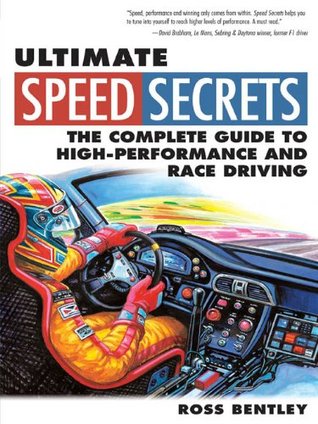More on this book
Kindle Notes & Highlights
by
Ross Bentley
Started reading
August 24, 2017
“The more I learn, the less I know for sure.
“A sure sign of
insanity is doing the same thing over and over again and expecting something to change.
practicing the wrong thing will only make you better at doing the wrong thing.
sit as upright as possible, with your shoulders back (not hunched forward) and your chin up. Of course, the lower you sit in the car the better.
place your hand at the top of the steering wheel (at the 12 o’clock position) and still have a bend at the elbow without pulling your shoulder off the seat back.
reach the shifter comfortably. You may have to modify or adjust the shifter to suit.
fully depress the pedals and still have a slight bend in the legs.
use the balls of your feet on the pedals.
When you are not using the
clutch, the left foot should be on t...
This highlight has been truncated due to consecutive passage length restrictions.
help support your body under the heavy braking and cornering forces
Before getting into your car and heading out onto the track, make sure that both the pedals and the bottom of your shoes are dry and clean.
wipe your shoes with a clean rag before getting into the car.
Only use the best seat belts in your car, and then take good care of them. Keep them clean and inspect them often for wear and damage.
head restraint behind your helmet.
roll cage or
cockpit that you could come in contact with during a crash is covered with a h...
This highlight has been truncated due to consecutive passage length restrictions.
keep the cockpit cool. Have air ducts installed to direct air at you.
tachometer, oil pressure, oil temperature, and water temperature,
see them easily and read them at a glance.
quick glance at the gauges, checking more for a change of position of a needle,
ideal needle position should be at 12 o
gauges don’t reflect the sunlight into your eyes
A simple dashboard layout is best, with as few gauges as possible.
Every time your foot goes onto the brake pedal, think of the word “squeeze,” then think of the word “
Anytime you pounce on the gas pedal or abruptly lift off, it unsettles the car, which reduces traction.
When you are moving your foot from the throttle to the brake pedal, or vice versa, it must be done as quickly as possible. Your right foot should always be either on the throttle (even if it’s a light, steady throttle) or the brakes. Don’t waste time doing nothing,
allow both hands to do an equal amount of work.
Make small steering corrections with the wrist, not the arms.
If you feel or hear the front tires scrubbing or squealing through a turn, try to unwind your steering input (straighten it out).
In racing, it is just as important to know what’s behind and beside you as it is to know what’s in front.
quick glance in the mirrors each time I come onto a straightaway
by using the engine to slow the car you can actually hinder accurate brake modulation and balance.
(if the brakes are right at the limit before locking up, and then you add engine braking to the rear wheels, you will probably lock up the rear brakes) and more wear and tear on the engine.
The tricky part is continuing maximum braking while blipping the throttle at the same time.
body. If you don’t blip enough, the driving wheels will lock up when the clutch is reengaged.
If you blip too much, the car will attempt to accelerate when you are supposed to be slowing down.
The best way is to rev up the engine slightly high...
This highlight has been truncated due to consecutive passage length restrictions.
When the brake pedal is fully depressed, it should still be slightly higher and directly beside the gas pedal.
add an extension to the throttle to suit you.
Make sure you always complete your downshifts before you turn into a corner.
As the driver lets out the clutch (usually, without a smooth heel-and-toe downshift), the driving wheels begin to lock up momentarily, and the car starts to spin.
You want to shift at an rpm that allows the engine to stay in the peak torque range.
When you are proficient at smooth, well-timed downshifts, try skipping gears when downshifting.
You must slow down the car with the brakes even more before dropping the two gears.
Now, with some cars, it seems the gearbox doesn’t like it when you skip gears.
unnecessary to double-clutch in production-based race cars with their synchromesh transmissions.
Again, I think it’s important for a driver to know how to drive without the clutch. You never know when you’re going to have a clutch problem and be forced not to use it.


